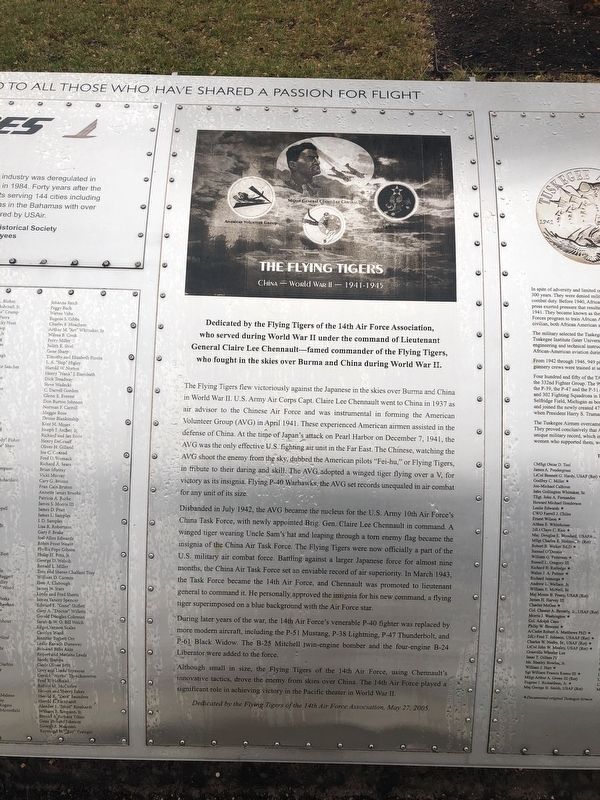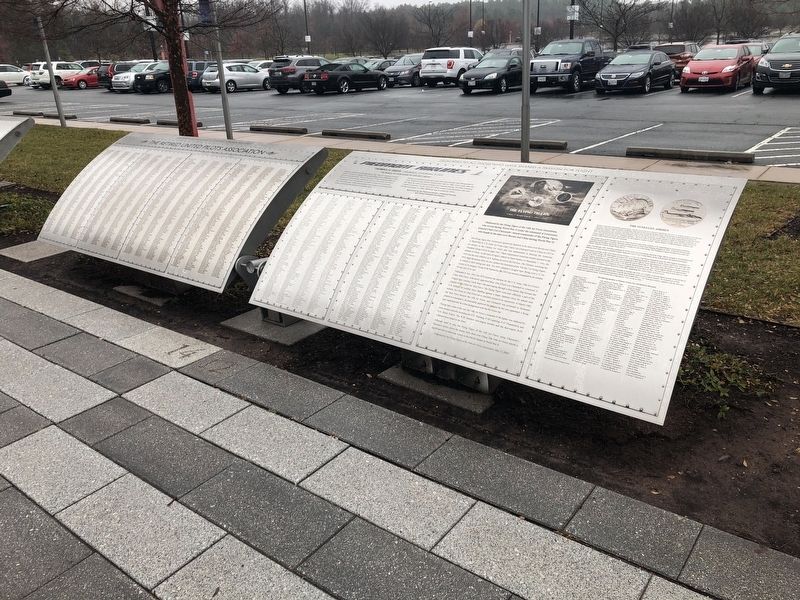Chantilly in Fairfax County, Virginia — The American South (Mid-Atlantic)
The Flying Tigers
China — World War II — 1941-1945
Dedicated by the Flying Tigers of the 14th Air Force Association, who served during World War II under the command of Lieutenant General Clair Lee Chennault—famed commander of the Flying Tigers, who fought in the skies over Burma and China during World War II.
The Flying Tigers flew victoriously against the Japanese in the skies over Burma and China in World War II. U.S. Army Air Corps Capt. Claire Lee Chennault went to China in 1937 as air advisor to the Chinese Air Force and was instrumental in forming the American Volunteer Group (AVG) in April 1941. These experienced American airmen assisted in the defense of China. at the time of Japan's attack on Pearl Harbor on December 7, 1941, the AVG was the only effective U.S. fighting air unit in the Far East. The Chinese, watching the AVG shoot the enemy from the sky, dubbed the American pilots "Fei-hu," or Flying Tigers, in tribute to their daring and skill. The AVG adopted winged tiger flying over a V, for victory as its insignia. Flying P-40 Warhawks, the AVG set records unequaled in air combat for any unit of its size.
Disbanded in July 1942, the AVG became the nucleus for the U.S. Army 10th Air Force's China Task Force, with newly appointed Brig. Gen. Claire Lee Chennault in command. A winged tiger wearing Uncle Sam's hat and leaping through a torn enemy flag became the insignia of the China Air Task Force. The Flying Tigers were now officially a part of the U.S. military air combat force. Battling against a larger Japanese force for almost nine months, the China Air Task Force set an enviable record of air superiority. In March 1943, the Task Force became the 14th Air Force, and Chennault was promoted to lieutenant general to command it. He personally approved the insignia for his new command, a flying tiger superimposed on a blue background with the Air Force star.
During the later years of the war, the 14th Air Force's venerable P-40 fighter was replaced by more modern aircraft, including the P-51 Mustang, P-38 Lighting, P-47 Thunderbolt, and P-61 Black Widow. The B-25 Mitchell twin-engine bomber and the four-engine B-24 Liberator were added to the force.
Although small in size, the Flying Tigers of the 14th Air Force, using Chennault's innovative tactics, drove the enemy from skies over China. The 14th Air Force played a significant role in achieving victory in the Pacific theater in World War II.
Erected 2005 by The Flying Tigers of the 14th Air Force Association.
Topics. This historical marker is listed in these topic lists: Air & Space • War, World II. A significant historical month for this entry is March 1943.
Location. 38° 54.684′
Other nearby markers. At least 8 other markers are within walking distance of this marker. The Tuskegee Airmen (here, next to this marker); Piedmont Airlines (here, next to this marker); F-100 Super Sabre Society (here, next to this marker); F-86 Sabre Pilots Association (here, next to this marker); The Distinguished Flying Cross Society (here, next to this marker); Sully Plantation (approx. 0.6 miles away); Robert Edward Wagstaff (approx. 0.6 miles away); Heirloom Garden (approx. 0.6 miles away). Touch for a list and map of all markers in Chantilly.
Credits. This page was last revised on December 1, 2019. It was originally submitted on December 1, 2019, by Devry Becker Jones of Washington, District of Columbia. This page has been viewed 182 times since then and 15 times this year. Photos: 1, 2. submitted on December 1, 2019, by Devry Becker Jones of Washington, District of Columbia.

